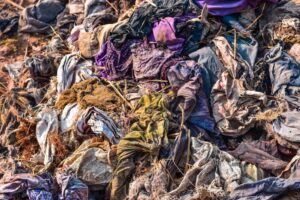 Our world currently revolves around massive industry and consumerism. In the most recent decades, textile consumption has increased at an alarming rate, harboring many problems in its wake. Few reactionary measures have been put in place due to uninformed, and even ignorant consumers. This large consumer population has become inappropriately accustomed to cheap and trendy fashion. However, no matter how inexpensive and harmless something like fast fashion might seem, someone, somewhere will always be paying a price.
Our world currently revolves around massive industry and consumerism. In the most recent decades, textile consumption has increased at an alarming rate, harboring many problems in its wake. Few reactionary measures have been put in place due to uninformed, and even ignorant consumers. This large consumer population has become inappropriately accustomed to cheap and trendy fashion. However, no matter how inexpensive and harmless something like fast fashion might seem, someone, somewhere will always be paying a price.
My name is McKenna Kundis, and I am a Girl Scout from Chesapeake, Virginia. I am currently working towards earning my Gold Award. When I began to brainstorm topics and community issues I resonated with most, I discovered the disregarded issue that is the fast fashion industry. I knew instantly I wanted to make a change, even just a small one, when it came to this normalized unsustainability. My project is called “Sustainable Seams”, and I am hoping it will positively nudge consumers into greener habits when it comes to textile consumption.
The biggest problem, as previously mentioned, is the lack of awareness regarding the industry. So, let me explain it a little. Fast Fashion is the massive production of cheap and disposable clothing. By disposable, I mean trendy. Clothing production is outsourced and made quickly to meet the timeline of short-lived trends. Consumers then purchase these items at a low cost, wear them as long as a trend survives, and then dispose of them. Fast fashion is now the second largest polluter in the world, only behind oil, and there are innumerable environmental and social impacts that result from this practice.
Production, which is only a minor step in the long life of a particular textile, greatly pollutes and contaminates our planet. The production of synthetic fabrics, such as polyester, and even natural fabrics, such as cotton, require insane amounts of natural resources. Did you know that the production of a single pair of jeans can use over 5,000 L of water? Pesticides and dyes also create heavy contamination of water supplies, which affect ecosystems occupied by both humans and animals. These are just a few ways that production can be harmful.
 Shockingly, production is only the beginning of the environmental impacts left by this industry. After production, these garments are consumed. Then, they are disposed of. In the “end,” these pieces find themselves in mountainous landfills. This is not the actual end, however, because most textiles do not decompose for over 200 years. Our planet is painfully congested and in great need of change. The environmental footprint this industry is exponentially leaving should be more than enough evidence to call for action. If we do not start to practice more sustainable textile consumption soon, fast fashion will slowly, but surely, kill our home. Let’s work together to take down fast fashion’s long-enduring reign.
Shockingly, production is only the beginning of the environmental impacts left by this industry. After production, these garments are consumed. Then, they are disposed of. In the “end,” these pieces find themselves in mountainous landfills. This is not the actual end, however, because most textiles do not decompose for over 200 years. Our planet is painfully congested and in great need of change. The environmental footprint this industry is exponentially leaving should be more than enough evidence to call for action. If we do not start to practice more sustainable textile consumption soon, fast fashion will slowly, but surely, kill our home. Let’s work together to take down fast fashion’s long-enduring reign.
Follow my project on social media and stay tuned for more educational posts right here on askHRgreen!
Instagram: @sustainableseams_
YouTube: Sustainable Seams
 Blog post contributed by McKenna Kundis, student at Chesapeake Public Schools and Girl Scout Gold Award candidate.
Blog post contributed by McKenna Kundis, student at Chesapeake Public Schools and Girl Scout Gold Award candidate.